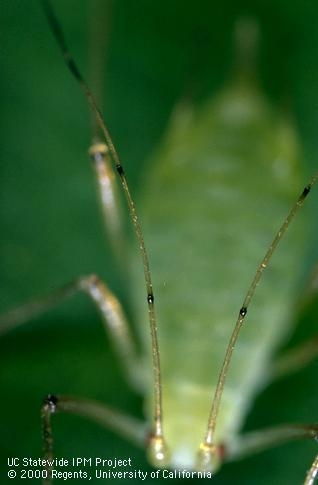Spring is the optimal time for aphids to flourish. The cool weather is perfect for many aphid species to build-up high numbers. Some aphid species prefer hot conditions but as a general rule cool weather and aphids go “hand-in-hand”. Cole crops, roses, other ornamentals, etc. are stressed by aphids in the spring. Four species of aphids infest alfalfa with the pea aphid and blue alfalfa aphid being favored by the cooler conditions. The spotted alfalfa aphid prefers hot weather and the fourth species, the cowpea aphid, appears to also like hot conditions but populations have also been found at other times of the year.
How do you tell these species apart? A pictorial key is located here:
(http://www.ipm.ucdavis.edu/PMG/C001/m001epaphid.html)
and an additional alfalfa aphid key can be found here:
(http://ceriverside.ucanr.edu/newsletters/Postings_from_the_Palo_Verde_Valley39363.pdf).
For right now, separating the pea aphid and blue alfalfa aphid is of utmost importance. This can be done with a hand lens and a “good eye”. Both are blue-greenish (the pea aphid has a biotype that is pinkish but it is less common). Looking at the aphid antennae, which stick out from the front of the insect, the pea aphid has 3 to 4 narrow dark bands along the antennae which are tan in color whereas the antennae of the blue alfalfa aphid are uniformly brown. Based on my observations and received reports, both species are problematic in alfalfa right now from Kern Co. south with the blue alfalfa aphid causing the most problems. Some areas with high, persistent blue alfalfa aphid populations exist and these are very problematic. In the central SJV and Sacramento Valley, presently pea aphid populations are common.


MANAGEMENT
Host plant resistance: One of the great success stories in IPM of alfalfa has been the host plant resistance that is bred into commonly grown alfalfa varieties. The resistance differs by variety and this information is summarized in this document which was probably consulted before selecting the variety to plant. http://www.alfalfa.org/pdf/2013%20NAFA%20Variety%20Leaflet.pdf.
This host plant resistance functions against pea aphid, blue alfalfa aphid, and spotted alfalfa aphid (probably most active against the latter two species). So why are we seeing high populations of pea and blue alfalfa aphid now? One fact is that the resistance is not fully functioning during cool periods. One published paper showed that at 15 °C (59 °F) the resistance was only partially effective against the aphid pests, but at 20 °C (68 °F) the plant resistance was fully functioning. These temperatures would correspond with daily average temperature, not daily high temperatures. So it is not uncommon to see some build-up of blue alfalfa aphid and pea aphid in the spring before the temperatures warm, but the outbreak of blue alfalfa aphid this year is more serious than normal. Once the conditions get to 85 °F daily high and 70 °F night temperatures, the resistance should be 100% active. Blue alfalfa aphids develop down to 38 °F so the cool temperatures really do not stop this species (pea aphid prefers slightly higher temperatures).
Insecticides: The suite of insecticides registered in alfalfa with activity on aphids is fairly small, i.e., much less than on many other crops. Chlorpyrifos, malathion, and dimethoate are organophosphate materials with good activity against aphids and several pyrethroid active ingredients may also control aphids. There are, of course, premix products of these active ingredients. I have seen good control of pea aphid with all these materials. In the upper SJV/lower Sacramento Valley where I am located, there are not large populations of blue alfalfa aphids but reports I have received suggest that the knockdown of this species is satisfactory with these products but that the residual control is limited to 3 or 4 days. After this, damaging aphid populations reappear both from a build-up of surviving aphids and from reinfestation from winged aphids.
Biological Control: Numerous biological control organisms help with aphid management. Several species of lady beetles, green lacewings, bigeyed bugs, damsel bugs, and syrphid fly larvae also play a role. Parasitic wasps can be important in some situations. Large golden-brown aphid mummies on the upper surfaces of leaves indicate parasitization. Aphids may also be controlled by a naturally occurring fungal disease, which is most prevalent during cool, rainy weather.
In summary, rumors of insecticide resistance in blue alfalfa aphid have been common. At this point, there is no scientific evidence of this. Aphids do characteristically develop resistance and this has been seen in other crops to several classes of insecticide chemistry. Since there are only two classes of chemistry available to control aphids in alfalfa, these need to be preserved for the long-term. Following good IPM practices including proper sampling, appropriate treatment thresholds, using non-chemical controls as much as possible, etc. will also help preserve these chemistries. While these cool spring conditions are very nice for human activities, some hot summer conditions will also help alleviate this aphid outbreak, I believe.

